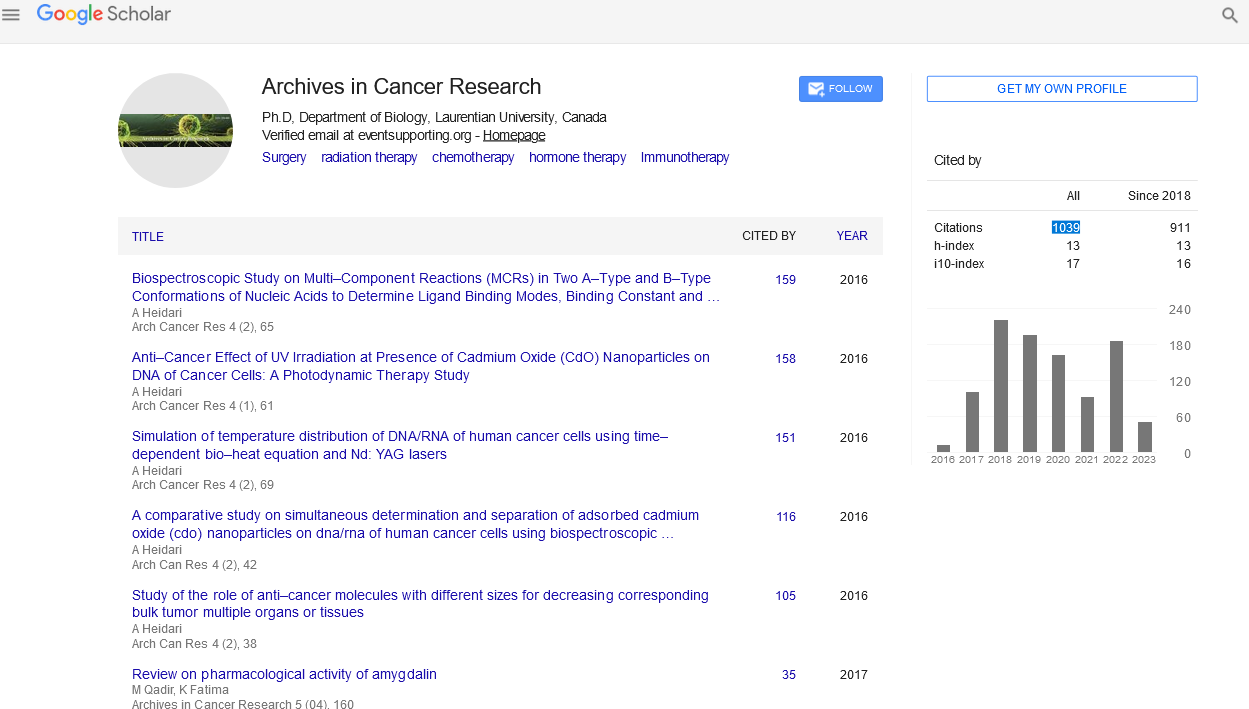Review Article - (2022) Volume 10, Issue 10
Bladder cancer cells' migration and proliferation are suppressed by EDARADD silencing.
Maybelline Frensik*
Department of Radiology, Icahn School of Medicine at Mount Sinai United State, United States
*Correspondence:
Maybelline Frensik, Department of Radiology, Icahn School of Medicine at Mount Sinai United State,
United States,
Email:
Received: 29-Sep-2022, Manuscript No. IPACR-22-13106;
Editor assigned: 03-Oct-2022, Pre QC No. IPACR-22-13106;
Reviewed: 10-Oct-2022, QC No. IPACR-22-13106;
Revised: 17-Oct-2022, Manuscript No. IPACR-22-13106;
Published:
27-Oct-2022, DOI: 10.36648/2254-6081-10.10-153
Abstract
Bladder cancer could be a quite common malignant cancer within the urinary apparatus. The expression of EDARADD (ectodysplasin-A receptor-associated death domain) in bladder cancer is beyond the conventional samples. However, its role in bladder cancer remains unknown. Within the gift study, we tend to analyze the expression of EDARADD in eighty one bladder cancer samples by assay additionally as its correlation with clinical characteristics. Additionally, the role of EDARADD was additionally explored through loss of perform. Cell proliferation assay and MTT assay were conducted to assess the proliferation of bladder cancer cells and trans well assay and wound healing assay were conducted to assess the migration of bladder cancer cells. On the opposite hand, the degree of epithelialmesenchymal transition (EMT) associated proteins and therefore the key molecules within the MAPK sign pathway were detected by western blot. in vivo experiments were additionally conducted to see the impact of EDARADD silencing on the metastasis of bladder cancer cells and therefore the MAPK sign pathway.
Keywords: Bladder cancer; Metastasis; Proliferation; Liquid biopsy; Biomarker; Diagnosis; Cancer research
Introduction
Bladder cancer could be a quite malignancy within the urinary apparatus, accounting for nearly three-dimensional of all cancers within the world there square measure AN calculable eighty three,730 new cases and seventeen,200 deaths. The bladder cancer incidence in males is beyond that in females, with a pair of to three times morbidity and mortality of females. Thanks to its high metastasis and repeat additionally as lacking effective treatment, bladder cancer causes a significant burden to patients. though within the past decades, important enhancements are created within the treatment and surgery, the prognosis of bladder cancer patients remains poor, with a 5-year survival of thirty third in bladder cancer patients, however fivehitter in pathological process bladder cancer [1,2]. Thus, work the molecular mechanism of bladder cancer is important to its designation and medical aid.
In the gift study, we tend to explore the role of EDARADD in bladder cancer. EDARADD is extremely expressed in bladder cancer in keeping with our results and information from TCGA. Additionally, its expression was correlative to the neoplasm stage and survival. It’s indicated that EDARADD could also be involved in bladder cancer method. Here during this study, we tend to showed that EDARADD silencing inhibited the expansion and metastasis of bladder cancer that provides further proof for our hypothesis that EDARADD could participate in bladder cancer development. Also, our study indicates that EDARADD could become a probable target for the treatment of bladder cancer, providing a unique insight for bladder cancer medical aid.
Ectodysplasin-A receptor-associated death domain (EDARADD) locates on body it encodes EDARADD, A device within the ectodysplasin pathway that participates within the ectodermic development. It contains a death domain interacting with the ectodysplasin-A receptor (EDAR), one among the neoplasm death issue receptors. EDAR recruits caspase-8 to trigger cell necrobiosis and is related to development of tumors. Our previous study showed that EDARADD is extremely expressed in bladder cancer; but, it’s performing in bladder cancer remains unknown. On the opposite hand, EDARADD contributes to the expansion of tongue epithelial cell malignant neoplastic disease (TSCC) that encompasses a high level of EDARADD. Besides, few studies according the probable role of EDARADD in cancers.
Herein, within the gift study, the role of EDARADD in bladder cancer cells was explored through loss-of-function.
Discussion
Many sign pathways, as well as the mitogen-activated macromolecule enzyme (MAPK), modulate the expansion and metastasis of cancers. MAPKs, as well as ERK (extracellular signalregulated kinase), P38 and JNK (c-Jun NH2-terminal kinase), square measure a category of enzymes changing living thing signals into living thing via catalyzing the phosphorylation of target substrates. MAPK signal acts a significant role in several life processes, as well as proliferation, differentiation, and necrobiosis. In bladder cancer, MAPK signal is activated and contributes to the progression of bladder cancer. Activation of the MAPK signal promotes the cell cycle transition of bladder animal tissue cells, therefore contributory to the proliferation and tumorigenesis of bladder cancer.
Additionally, suppression of the MAPK signal will hinder the synthesis of DNA, modulate the cell cycle method and induce necrobiosis, therefore inhibitory the expansion of bladder cancer cells. It’s indicated that MAPK could become a target for bladder cancer medical aid [3,5]. Within the gift study, we tend to explored whether or not MAPK signal is involved within perform of EDARADD in bladder cancer. We tend to found that EDARADD silencing suppressed the expansion and metastasis of bladder cancer cells and modulated activation of MAPK signal, indicating a very important role of EDARADD within the development of bladder cancer. It’s going to become a promising therapeutic target for the treatment of bladder cancer.
Bladder cancer information were downloaded from TCGA (The Cancer order Atlas) to investigate the expression of EDARADD in bladder cancer samples. Nineteen bladder cancer and paired traditional samples were analyzed during this study. Following information filtering, standardization victimisation cut mean of m-values methodology and internal control victimisation biological constant of variation methodology, the EDARADD expression in bladder cancer and paired traditional samples was analyzed.
Cells were lyzed on ice with RIPA lysis buffer containing one metric linear unit phenylmethanesulfonyl halide (Beyotime, Shanghai, China), followed by ultra-sonication once action at 12000 ×g for quarter-hour at 4°C, a BCA macromolecule Assay Kit (Beyotime) was wont to verify the macromolecule concentration of the supernatants. Equal quantity of macromolecule samples was separated by V-day to twelve-tone system metal dodecyl salt polyacrylamide gel natural process and so transferred onto polyvinylidene halide (PVDF) membranes (Millipore, Bedford, MA, USA) once blockade, the PVDF membranes were incubated with primary antibodies against EDARADD E-cadherin Cell sign Technology), N-cadherin vimentin. Then the membranes were washed with TBST and incubated with corresponding HRP labeled secondary antibodies
EDARADD is concerned in ectodermic development. However, its role in cancers remains for the most part unknown. One characteristic of cancer is its abnormal proliferation. Within the gift study, we tend to disclosed that silencing EDARADD suppressed the proliferation of bladder cancer cells, with attenuate capability to create clones. These results recommend a doubtless oncogenic role of EDARADD in bladder cancer. Similar perform of EDARADD is found in TSCC. EDARADD silencing impacts the aptitude of TSCC cells to create clones and suppresses their proliferation additionally according that EDARADD silencing iatrogenic necrobiosis in TSCC cells [6,7]. Herein we tend to speculate that apoptosis-inhibition can also contribute to perform of EDARADD in bladder cancer cells. However, any exploration continues to be required.
Metastasis typically happens at late stage of cancer, which ends up in secondary cancer development. Neoplastic cell metastasis to body fluid nodes or distant organs could be a complicated multistep method, as well as neoplastic cell dissemination to vessels, transport, settlement, constitution, and growth. Metastasis of cancer cells contributes to cancer progression and death. Curiously the perform of EDARADD in neoplastic cell metastasis remains unknown. Here we tend to showed that EDARADD silencing suppressed the migration of bladder cancer cells in vitro. Systematically, silencing EDARADD additionally reduced the metastasis of bladder cancer cells in vivo. Also, EDARADD silencing attenuates the amount of MMP-2 that encompasses a shut relationship with neoplastic cell metastasis. As migration of cancer cells contributes to cancer metastasis, it's indicated that EDARADD {may be could additionally basis also} also involved within the metastasis of bladder cancer cells.
EMT could be a multistep method throughout that animal tissue cells acquire characteristics of mesenchymal cells, as well as motility and invasive properties EMT is considered AN initial step for the metastasis of bladder cancer a bunch of transcriptional factors, like snail, slug and twist, modulate the EMT method. Here we tend to incontestable the influence of EDARADD silencing on EMT, as proven by augmented, a marker of animal tissue cells, attenuate vimentin and Nâ?cadherin, markers of mesenchymal cells, and changes in EMT connected transcriptional factors. It’s indicated that EDARADD modulates the EMT method that provides any proof for our hypothesis that EDARADD could contribute to the event of bladder cancer [8-10].
Conclusion
To study EDARADD in bladder cancer, the EDARADD expression was additionally determined in a pair of bladder neoplastic cell lines: 5637 and T24. The ΔCt of 5637 cells was seven and therefore the and therefore the ΔCt of those a pair of cell lines was less than twelve that was considered a high abundance of EDARADD in bladder cancer cells. Additionally perform of EDARADD in bladder cancer cells were explored through loss-of-function. The infection potency of LV-shEDARADDs was detected by RT-qPCR and western blot. As detected by RT-qPCR, in 5637 cells infected with LVshEDARADDs, the relative RNA level of EDARADD was attenuate to zero. And in T24 cells infected with LV-shEDARADDs, the relative RNA level of EDARADD was attenuate to zero. Systematically, western blot assay showed similar results. In T24 cells and 5637 cells infected with LV-shEDARADDs, the macromolecule level of EDARADD was declined markedly these results incontestable that LV-shEDARADDs attenuate the expression of EDARADD at each RNA level and macromolecule level.
Acknowledgement
I would like to thank my professor for his support and encouragement.
Conflict of Interest
The authors declare that there is no Conflict of interest.
REFERENCES
- Freddie B, Jacques F, Isabelle S, Rebecca LS, Lindsey AT, et al. (2018) Global cancer statistics 2018: GLOBOCAN estimates of incidence and mortality worldwide for 36 cancers in 185 countries. CA Cancer J Clin68: 394-424.
Indexed at, Google Scholar , Crossref
- Benedito AC, Joshua JM, Timothy MK, Mariana S, Sarki AA (2015) Emerging therapeutic targets in bladder cancer. Cancer Treat Rev41: 170-178.
Indexed at, Google Scholar , Crossref
- Romero FM, Star H, Lav R, Watkins S, Harrison M, et al. (2017) The impact of the EDA pathway on tooth root development. J Dent Res96: 1290-1297.
Indexed at, Google Scholar , Crossref
- Jonathan V, Amelie R, Philippe C, Antonin T, Sarah D, et al. (2019) The ectodysplasin receptor EDAR acts as a tumor suppressor in melanoma by conditionally inducing cell death. Cell Death Differ 26: 443-454.
Indexed at, Google Scholar , Crossref
- Meng L, Ting B, Kun H, Dong X, Jian M (2020) Knockdown of ectodysplasin-A receptor-associated adaptor protein exerts a tumor-suppressive effect in tongue squamous cell carcinoma cells. Exp Therap Med19: 3337-3347.
Indexed at, Google Scholar , Crossref
- Meng L, Ting B, Kun H, Dong L, Meng J (2020) MAPK signalling in cellular metabolism: stress or wellness?. EMBO Rep 11: 834-840.
Indexed at, Google Scholar , Crossref
- Jun Guo Y, Pan WW, Sheng B, Zhong F, Ying X, et al. (2020) ERK/MAPK signalling pathway and tumorigenesis. Exp Therap Med19: 1997-2007.
Indexed at, Google Scholar , Crossref
- Gerald BS, Sefer E, Teresa B, Eva Marina S, Manal E, et al. (2021) Therapeutic and prognostic implications of NOTCH and MAPK signaling in bladder cancer. Cancer Sci112: 1987-1996.
Indexed at, Google Scholar , Crossref
- Zhao L, Zhang T, Geng H, Liu Z Q, Feng LZ, et al. (2018) MAPK/AP-1 pathway regulates benzidine-induced cell proliferation through the control of cell cycle in human normal bladder epithelial cells. Oncol Lett16:4628-4634.
Indexed at, Google Scholar , Crossref
- Binod K, Jane S, Lakshmipathi K, Sweaty K, Shandra W, et al. (2009) Differential effects of MAPKs signaling on the growth of invasive bladder cancer cells. Int J Oncol34: 1557-1564.
Indexed at, Google Scholar , Crossref
Citation: Frensik M (2021) Bladder Cancer
Cells' Migration and Proliferation are
Suppressed by EDARADD Silencing. Archives
Can Res, Vol.10 No. 10: 153.





